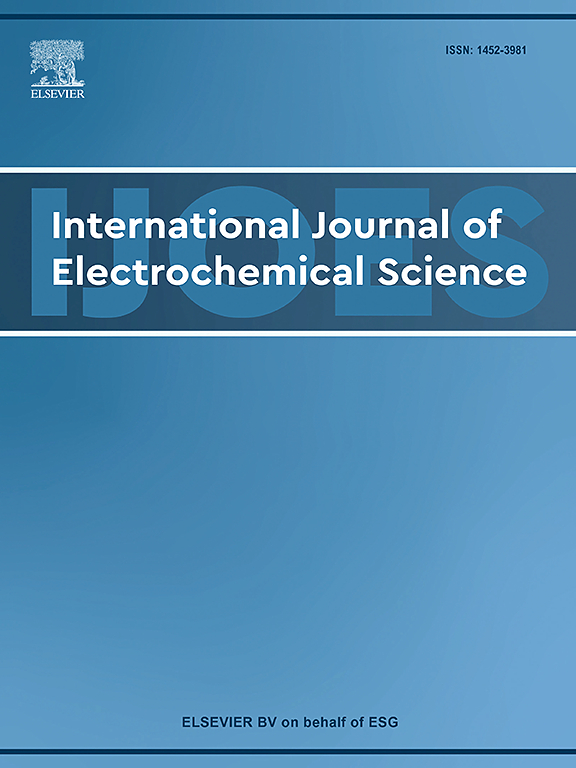基于等离子体处理的聚合物纳米结构电化学传感器的研制,用于双酚A的灵敏和可重复性检测
IF 2.4
4区 化学
Q4 ELECTROCHEMISTRY
International Journal of Electrochemical Science
Pub Date : 2025-07-05
DOI:10.1016/j.ijoes.2025.101121
引用次数: 0
摘要
人们普遍通过饮食和环境途径接触双酚A(一种干扰内分泌的化学物质),这引起了重大的公共卫生担忧。在本研究中,为了灵敏地检测BPA,我们开发了三种不同的电化学传感器(Au film, Au nanodimple (AuND)和Au nanopillar (AuNP)),并研究了电活性表面积对电化学传感性能的影响。采用简易等离子体处理工艺制备了支撑聚合物纳米结构(即NDs和NPs)。采用循环伏安法和电化学阻抗法对电极的电活性进行了评价。与其他电极材料(即Au膜和AuNPs)相比,具有高密度和高宽高比的AuNPs具有优异的氧化还原性能和低的电荷转移电阻。采用差分脉冲伏安法对双酚A进行了定量研究。在最佳实验条件下,在2 ~ 1000 nM的动态BPA浓度范围内,AuNP传感器具有良好的线性响应(R2 = 0.98)、纳摩尔灵敏度和高重复性(相对标准偏差≤3.1 %)。AuNP传感器在实际应用中的可行性也通过添加双酚a的人工泪液和尿液样本进行了检验。结果表明,植入AuNP平台的电化学传感器适用于污染水和生物体液中BPA的监测。本文章由计算机程序翻译,如有差异,请以英文原文为准。
Development of electrochemical sensors based on plasma-treated polymeric nanostructures for sensitive and reproducible detection of bisphenol A
Significant public health concerns have been raised regarding humans' ubiquitous exposure to bisphenol A (BPA), an endocrine-disrupting chemical, through dietary and environmental pathways. In this study, for the sensitive detection of BPA, we developed three different electrochemical sensors (i.e., Au film, Au nanodimple (AuND), and Au nanopillar (AuNP)) and investigated the influence of electroactive surface area on electrochemical sensing performance. The supporting polymeric nanostructures (i.e., NDs and NPs) were developed using facile plasma treatment processes. Cyclic voltammetry and electrochemical impedance spectroscopy were used to evaluate the electrodes' electroactivity. Compared with the other electrode materials (i.e., Au film and AuNDs), the AuNPs, which exhibited a high density and high aspect ratio, showed excellent redox behaviors and low charge transfer resistance. A quantitative investigation of BPA was conducted using differential pulse voltammetry. Under optimal experimental conditions, the AuNP sensors demonstrated a linear response (R2 = 0.98), nanomolar sensitivity, and high reproducibility (relative standard deviation ≤ 3.1 %) in the dynamic BPA concentration range from 2 to 1000 nM. The viability of the AuNP sensors in practical applications was also examined with BPA-spiked artificial tear and urine samples. The results highlight that the electrochemical sensors implanted with AuNP platforms are suitable for monitoring BPA in contaminated water and biofluids.
求助全文
通过发布文献求助,成功后即可免费获取论文全文。
去求助
来源期刊
CiteScore
3.00
自引率
20.00%
发文量
714
审稿时长
2.6 months
期刊介绍:
International Journal of Electrochemical Science is a peer-reviewed, open access journal that publishes original research articles, short communications as well as review articles in all areas of electrochemistry: Scope - Theoretical and Computational Electrochemistry - Processes on Electrodes - Electroanalytical Chemistry and Sensor Science - Corrosion - Electrochemical Energy Conversion and Storage - Electrochemical Engineering - Coatings - Electrochemical Synthesis - Bioelectrochemistry - Molecular Electrochemistry

 求助内容:
求助内容: 应助结果提醒方式:
应助结果提醒方式:


